Toy manufacturer Denys Fisher was the home of Doctor Who action figures in the 1970s. Today, we’re taking a look at their beloved, if not entirely accurate, range of figures.
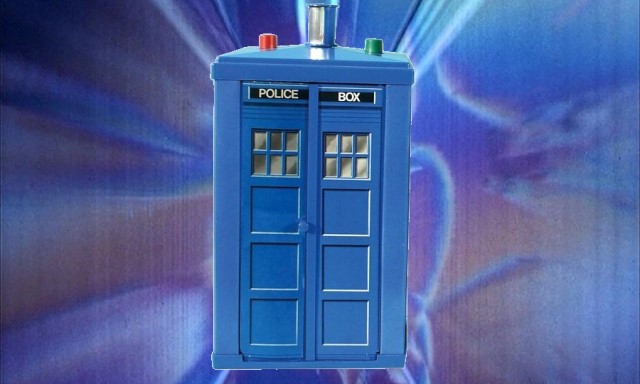
Doctor Who has been one of the most recognisable and enduring TV shows in the UK, if not the world, for almost 60 years. So it’s natural that there’s been an equally enduring desire by fans to bring a little bit of that world home with them. Unsurprisingly, that there has been no shortage of companies over the years looking to help those fans recreate their favourite adventures with Doctor Who action figures.
In the 1960s there was no shortage of Daleks in different sizes, colours and even shapes (and some of those were very odd shapes indeed) so it’s slightly surprising that it took until the 1970s for Doctor Who action figures representing the Doctor and their companions to arrive. When they did, the first ones came courtesy of toymaker Denys Fisher.
Was the Denys Fisher Fourth Doctor sculpt really based on Gareth Hunt?
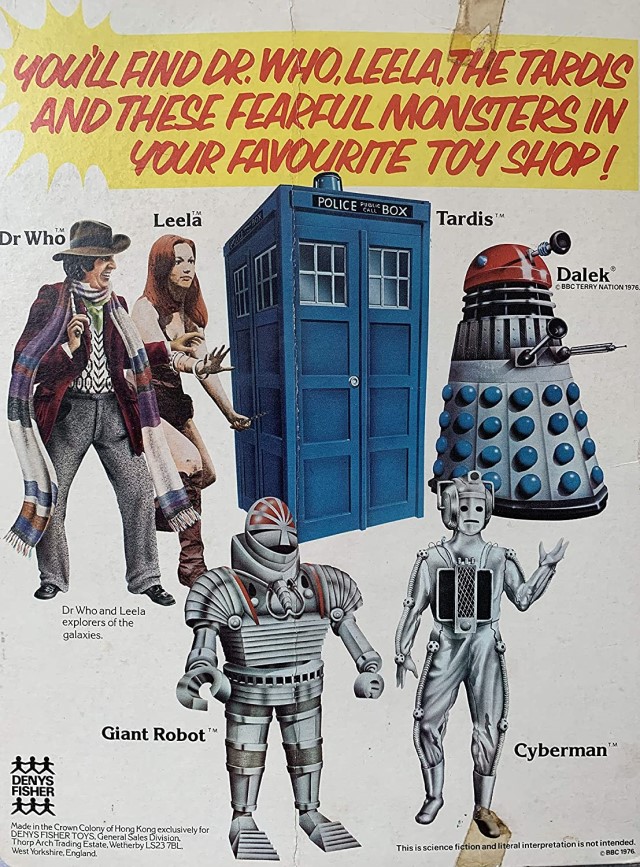
In 1976, they released doll-like figures of the TARDIS team of the Fourth Doctor, Leela and K9 in a 9.5″ scale, complete with cloth outfits. The world of Doctor Who action figures’ answer to Ken and Barbie, they’re a mixed bag in terms of accuracy, but great fun. The Doctor’s combination of burgundy jacket, check waistcoat, baggy grey trousers and plastic fedora (complete with accurately turned brim!) all suggest reference photos from ‘Terror of the Zygons’ loomed large on the Denys Fisher walls. Even his iconic sonic screwdriver is lovingly recreated with great accuracy for the scale.
On the other hand, the scarf is long and striped, but in a strange choice of purple and grey, while their version of Tom Baker’s famous toothy grin is instead a handsome smile in a heroically square-jawed face. It’s so off-piste that fans even stared an apocryphal rumour that they were leftover heads from dolls of New Avengers star Gareth Hunt, although that has since been debunked.
Meanwhile, Leela has the lollypop-headed proportions of most such dolls at the time, alongside a frankly magnificent bouffant that’s more Charlie’s Angels than Sevateem. But despite the slightly brighter colours, her leather outfit as seen in stories like ‘The Face of Evil’ is nicely recreated, complete with janus thorn pouch, scabbard and knife. It’s as lovely a piece of Doctor Who action figures goodness.
The Doctor and Leela were joined on their adventures by faithful robot dog K9. As the wider history of Doctor Who actions figures shows, K9 is harder to capture in plastic than you might think. But the Denys Fisher version is a fun one and does a pretty great job of bringing the tin dog to miniature life.
He sits neatly alongside his master and mistress – if just a little small – and has all the little details that you’d expect; his K9 logo, back button panel, tail, video screen and nose-laser are present and correct. Best of all, he contains a ‘pull back and go’ traction engine that means he can zoom across the floor, randomly crashing into walls – just like the real thing!
You could even get your own TARDIS for your Doctor Who action figures to call home
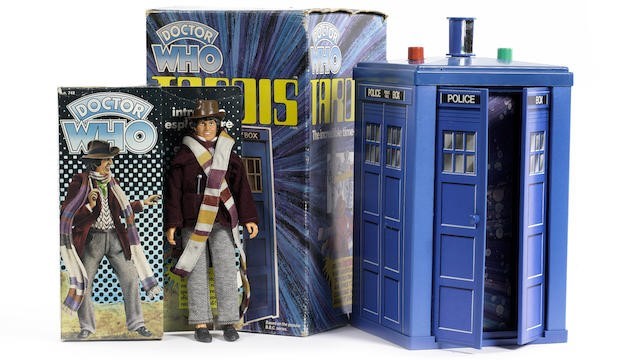
If the Denys Fisher K9 has a flaw, it’s that the head is a little oversized compared to the body. But that simply makes this K9 look even more loveable. And it’s a reasonable suspicion that this may have been a necessary compromise to balance the weight of the traction drive in the back to keep the figure on the ground when in motion. Not that K9 pulling a wheelie across your living room wouldn’t have been a fantastic sight.
Completing the team was something that fans had long been crying out for – their very own TARDIS! In scale with Denys Fisher’s other Doctor Who action figures, it was admittedly a much more approximate take on the iconic time machine compared to some of the ones that came later. The flat roof is actually accurate to the prop at the time, but its four walls are flats that have been printed to look like the Police Box rather than being genuinely segmented into the different panels and windows.
Most unfortunately, the door opening at the front extends right up into the Police Box sign, so while the sides and back have the correct ‘Police Public Call Box’ text, the front has to compromise with just ‘Police Box.’ There’s also the matter of the big red and green buttons on the top, but they actually link to one of the coolest things about this TARDIS. Not only could you fit one of the other Doctor Who action figures inside, but at a press of a button (and a twist of a knob) you could make them disappear!
The Doctor Who action figures range also included monsters to outwit
Of course, a Doctor is nothing without monsters to fight, so this line of Doctor Who action figures also included three villains drawn from the Doctor’s adventures. Strangely, the three chosen are in scale with each other, but just a little bit too small compared to the Doctor, Leela and the TARDIS.
This size difference is most obvious with the Dalek, which only comes up to the Doctor’s chest – short, then, even for one of the diminutive pepper pots. It also follows in the long-standing tradition of Doctor Who action figures, before and since, of having its own unique colour scheme. Although the body has the light grey and blue combination common during the 1960s, it’s topped by a bright red dome. Like a lot of Dalek toys, its proportions aren’t quite true to life, having a thinner, stretched-out appearance which elongates the upper body.
The K1 Robot from ‘Robot,’ meanwhile, probably looks about the right size to the casual eye, being just slightly shorter that the Fourth Doctor figure. It’s only when you consider that the actual metal menace on TV was 7’6″ that you see the problem. Some of the details and proportions are off too – although, in fairness, the changes seem to be aimed at making the whole thing less top-heavy, lest it falls over whilst threatening the world with Armageddon!
The final figure in the Denys Fisher Doctor Who action figures range was a Cyberman. Even for a monster that’s made up of spare parts by definition, it’s a curious concoction of mix-and-match elements. The original intent was probably to produce something like the Cybermen that had appeared in 1975’s ‘Revenge of the Cybermen.’ And certainly the head (with its large built-up sides like huge ear protectors) leans in that direction.
It is also clad in a baggy silver space suit – somewhat tighter than the one from ‘Revenge,’ with ball joints on the cables along its arms and legs, plus a helmet with a straight lower edge, meaning it actually contains more elements from the Cybermen seen in ‘The Moonbase.’
Did the Radio Times 10th Anniversary Special inspire the Denys Fisher Cyberman?
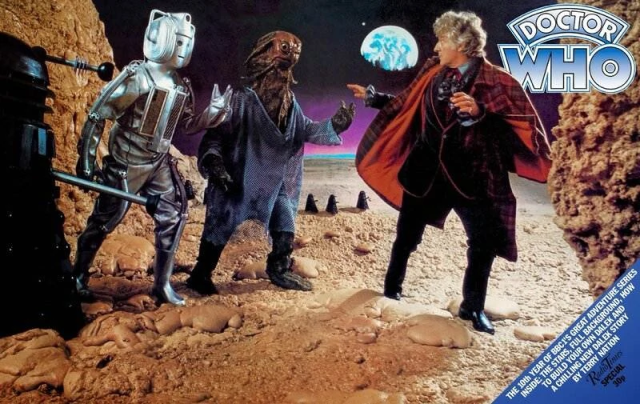
There’s one possible answer to how this mashup arrived. In 1973, the Radio Times printed a special supplement celebrating 10 years of Doctor Who. Its cover was from a special photoshoot featuring Jon Pertwee’s Doctor facing a horde of monsters. And the Cyberman for the shoot was cobbled together from whatever elements were to hand in the BBC’s wardrobe. The result was a Cyberman like no one had ever seen before – remarkably like the one that popped up in the Doctor Who action figures range three years later!
As such, the Denys Fisher collection retains a special place in the hearts of many a Doctor Who action figures fan. They may lack the laser-sight accuracy of some of the Doctor Who action figures which came later, but they have an innocent charm all their own. And rarely have the likes of Cybermen and the Doctor seemed so adorable, even cuddly.
Do you have any of the Denys Fisher models in your Doctor Who action figures collection? Or maybe you had one growing up? Let us know in the comments. And if you’re younger, would you like to see a return of the doll-like style for future Doctor Who action figures?
Meanwhile, at least one fan has created their own cosplay of the Denys Fisher Fourth Doctor. Does this mean we need a Denys Fisher Lovarzi scarf?!
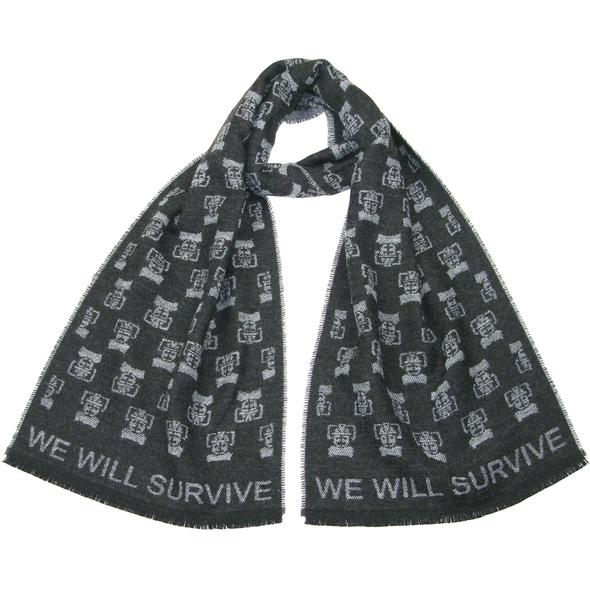
Cybermen Doctor Who scarf – order now from the Lovarzi shop!








Nice article. I believe the Cyberman and Dalek were actually based on the Weetabix cards that were out in 1975, with artwork by the brilliant Gordon Archer. There is a red domed Dalek in the set, and perhaps he based his Cyberman on the Radio Times photo, as it looks very similar.